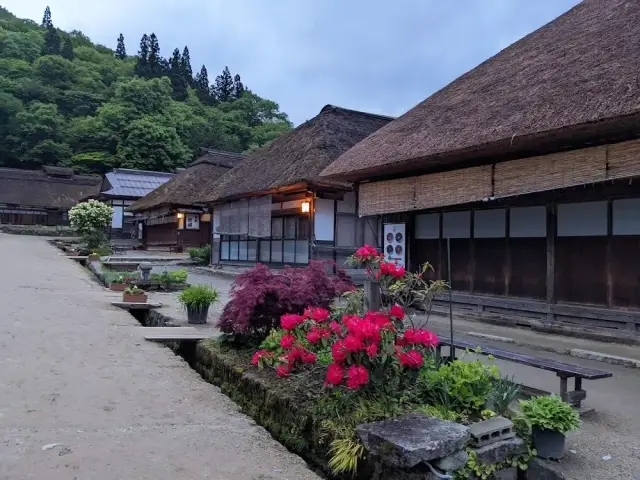https://www.dekitabi.com/itinerary/ochijuku-tsuruga-castle-tour
Japan’s rich tapestry of history, culture, and natural beauty offers countless experiences for travelers seeking to explore beyond the typical tourist trails. In the heart of Fukushima Prefecture, three remarkable sites—Ouchi-juku, Tsuruga Castle, and the Fukushima Prefectural Museum—invite visitors to immerse themselves in the essence of Japan’s past and present.
Ouchi-juku: A Step Back in Time

https://www.dekitabi.com/attraction/ouchijuku
Nestled in the picturesque Aizu region, Ouchi-juku is a beautifully preserved post town that harks back to the Edo period. This charming village was once a crucial stop along the Aizu-Nishi Kaido, an ancient trade route. Today, Ouchi-juku stands as a living museum, offering a glimpse into traditional Japanese rural life.
Walking through Ouchi-juku, visitors are greeted by thatched-roof houses that seem to whisper stories of a bygone era. The village’s architecture, with its wooden structures and traditional roof styles, evokes a sense of nostalgia and tranquility. The well-preserved streets are lined with local shops and eateries, where travelers can sample regional delicacies such as soba noodles made from buckwheat grown in the area.
One of the highlights of Ouchi-juku is its annual festival, which celebrates traditional crafts and customs. The festival’s vibrant atmosphere, combined with the village’s historical ambiance, provides a unique opportunity to experience Japan’s cultural heritage firsthand. For those interested in photography, Ouchi-juku offers numerous scenic vistas that capture the timeless beauty of rural Japan.
Tsuruga Castle: The Heart of Aizu

https://www.dekitabi.com/attraction/tsuruga-castle
Tsuruga Castle, also known as Aizu-Wakamatsu Castle, stands as a symbol of the Aizu region’s storied past. Located in Aizu-Wakamatsu City, this imposing fortress played a pivotal role during the Boshin War, a pivotal conflict in Japan’s history. Built in the early 17th century, the castle’s striking architecture and historical significance make it a must-visit destination for history enthusiasts.
The castle’s distinctive red-tiled roof and elegant, wooden structure reflect the architectural style of the era. Visitors can explore the castle’s well-preserved interiors, which house exhibits detailing the history of the Aizu domain and the castle’s role in the Boshin War. The castle’s grounds also offer a picturesque setting for leisurely walks, with beautifully landscaped gardens and views of the surrounding landscape.
Tsuruga Castle is not just a historical site; it is also a venue for cultural events and festivals throughout the year. The annual Tsuruga Castle Sakura Festival, held during cherry blossom season, transforms the castle grounds into a sea of pink and white, creating a stunning visual spectacle. The combination of historical significance and natural beauty makes Tsuruga Castle a highlight of any visit to Fukushima Prefecture.
Fukushima Prefectural Museum: A Journey Through Fukushima’s History and Culture

https://www.dekitabi.com/attraction/fukushima-prefectural-museum
The Fukushima Prefectural Museum, located in the heart of Fukushima City, offers an in-depth exploration of the region’s rich cultural and historical heritage. Established in 1966, the museum houses an extensive collection of artifacts, artworks, and exhibits that showcase the diverse history of Fukushima Prefecture.
The museum’s exhibitions cover a wide range of topics, from ancient archaeological finds to contemporary art. Visitors can view artifacts from the Jomon and Yayoi periods, learn about the region’s traditional crafts, and explore exhibits on local folklore and customs. The museum’s well-curated displays provide valuable insights into the cultural and historical development of Fukushima Prefecture.
One of the museum’s key attractions is its collection of samurai armor and weapons, which offers a fascinating glimpse into Japan’s feudal era. Additionally, the museum’s art galleries feature works by both traditional and contemporary Japanese artists, providing a comprehensive view of the region’s artistic heritage.
The Fukushima Prefectural Museum also hosts special exhibitions and events throughout the year, making each visit a unique experience. Whether you are a history buff, art lover, or simply curious about Fukushima’s heritage, the museum offers something for everyone.
Conclusion
Ouchi-juku, Tsuruga Castle, and the Fukushima Prefectural Museum are three remarkable destinations that encapsulate the essence of Fukushima Prefecture’s historical and cultural richness. Each site offers a unique perspective on Japan’s past and present, providing visitors with unforgettable experiences and insights into the region’s heritage. Whether exploring the charming streets of Ouchi-juku, delving into the history of Tsuruga Castle, or discovering the treasures of the Fukushima Prefectural Museum, travelers are sure to find themselves immersed in the captivating stories and beauty of Fukushima.


Leave a Reply